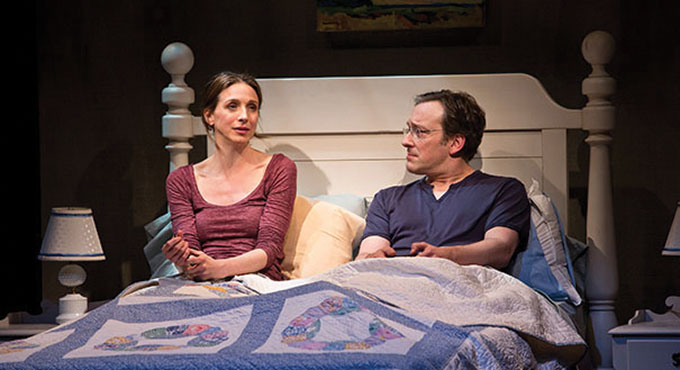Dinner With Friends
by Anthony Chase

Dinner With Friends
At the Roundabout in New York City
Sometimes it seems that our lives only gain meaning retrospectively. A moment only becomes important in the context of subsequent events: people we meet, opportunities we forego. Adding complication to this reality, the meaning of events that would logically seem to be frozen in the past can take on radically different meaning as time goes by—as love expires, as lies are revealed, as offences are forgiven. Pam MacKinnon’s new production of Donald Margulies’s Pulitzer Prize winning play, Dinner With Friends, examines this reality with aching beauty and sometimes mocking humor as it explores what happens to two married couples, longtime friends, when one couple breaks up.
MacKinnon, who originally hales from Buffalo, has been wowing the theatrical world with her direction of a succession of remarkable high-profile productions, including the Pulitzer Prize winning Clybourne Park and her Tony Award winning direction of Who’s Afraid of Virginia Woolf.
In revisiting Margulies’s intriguing and disturbing exploration of close friendship and marriage, MacKinnon is able to tap into what she does best, expose layer upon layer of nuance in a brilliant script. Her artfulness is given a particular powerful showcase by scenes that are organized out of chronological sequence.
Gabe and Karen, played by Jeremy Shamos and Marin Hinkle, experience the breakup of their dear friends Tom and Beth, played by Darren Pettie and Heather Burns, very differently. Gabe and Tom are best friends, as are Karen and Beth. The first couple actually introduced the second, we are to learn. But whereas Karen responds with utter disbelief to the news that her friends’ marriage is over, that Tom is feeling smothered and is in love with someone else, Gabe tellingly retreats into silence.
This startling development will test everyone and bring every relationship into question.
Jeremy Shamos, who also appeared in Clybourne Park, is similarly wonderful here. He gets remarkable mileage out of Gabe’s frequent inability or unwillingness to express himself, drawing us into the character’s discomfort and crisis of belief. Marin Hinkle’s performance as Karen, however, is where I found the most thrilling revelation. Her efforts to be as good a friend as she can be extend to encouraging Beth’s artwork, introducing her to her future husband, and smoothing life’s every rough edge. To her shock, these good deeds will not go unpunished. We feel her pain with a sense of communal betrayal.
More than the breakup itself, Gabe and Karen find it challenging to navigate the seeming happiness that Tom and Beth find after their divorce. The production travels this journey with marvelous believability and deft articulation. Indeed the reality is so palpable that audience members are likely to find themselves either, like Karen, effusively critiquing the characters aloud as they leave the theater, or falling into silent contemplation like Gabe. Indifference is impossible.
|
Issue Navigation> Issue Index > v13n9 (Week of Thursday, February 27) > Theater Week > Dinner With Friends This Week's Issue • Artvoice Daily • Artvoice TV • Events Calendar • Classifieds |









 Current Issue
Current Issue